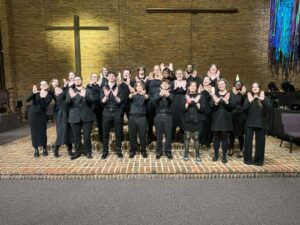In a time when words are often left without responses, perhaps it is time to converse through a more unconventional form of communication: dance.
A crowd of about 60 students and faculty assembled in Bailey Auditorium to listen to a lecture by ShaDawn Battle, professor of English, last Tuesday, Feb. 18. The event titled “Praisesong and Chicago Footwork: Locating a Black Diasporic Spiritual Heritage,” was part of a two-day Chicago Footwork showcase at Wittenberg. Following a presentation of Chicago Footwork and a workshop on Monday evening, the lecture was an opportunity for Battle to preview her upcoming manuscript and documentary about Chicago Footwork.
Battle was introduced by Julius Bailey, the Wittenberg director of African and Diaspora studies and associate professor.
“As colleagues, we appreciate her honesty,” Bailey said. “Today, though, she is here as a scholar.”
Battle began the presentation by describing the history of Chicago Footwork, as well as her personal experience with the art form.
“[Footwork] is an urban dance style characterized by multiple combinations of rapid, improvised, syncopated movements of the feet, often accompanied by symmetrical hand gestures,” Battle said.
Chicago Footwork took its first steps in the 1980s. Flowing from the inner-city, Chicago Footwork was initially believed to be an “inferior” form of dance. Now a global phenomenon, Chicago Footwork has stomped out discriminatory expectations at the unified tempo of 160 beats per minute.
Battle’s documentary, “Footwork Save my Life: The Evolution of Chicago Footwork,” will highlight the gravity of footwork on the lives of many performers including her own. Battle explained that her aspiration with the project is to give audiences an “insider’s perspective” and delineate “the evolution of the art form.”
“As the art form continues to spread beyond the confines of the South and West Sides of Chicago, it is important that the genealogy is made clear, and that the cultural and environmental conditions that led to its birth remain a part of the conversation,” Battle said.
One aspect of Chicago Footwork that Battle is especially interested in is its communicative potential. As both a focus in her manuscript and the documentary, Battle analyzes Black vernacular and the ways Chicago Footwork can serve as a language. In a similar light to the way a wave signals a hello, footwork steps can be combined to tell a story through movement. Battle provided an example by playing a clip of a famed footworker demonstrating the way he has used Chicago Footwork to convey events.
Many footworkers have turned to YouTube to display their skills and post Chicago Footwork tutorials. The YouTube video “How to Footwork Step by Step Tutorial Starring King Charles X Pause Eddie” provides viewers with a few Chicago Footwork steps including “Skates,” a step that involves rapidly crisscrossing the feet and arms, and “Mikes,” a step performed by turning the feet in and out with increasing speed.
Greg “LG” McLendon , the executive producer, assistant director and music director of the documentary, said that he believes Chicago Footwork has the potential to “speak” diversity to communities.
“Diversity inspires innovation and innovation pushes societies forward. Dance is a form of art and art is one’s expression of its perception,” McLendon said. “To learn is to understand a variety of perceptions.”
The documentary is currently in the filming process and will be released in the next few years. This multiple-year project will do more than simply provide viewers with a presentation of Chicago Footwork. This documentary, and the conversations it fosters, can entice viewers to debate one important question: what form of art has changed their lives?







